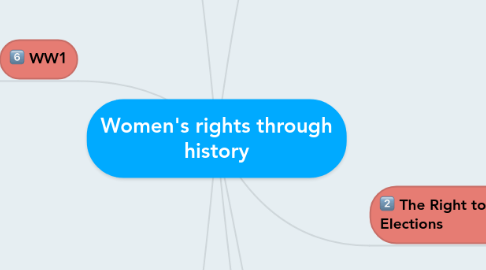
1. 1920: The creation of the Dominion Elections Act marked the beginning of the modern era in the history of voting in Canada.
2. Each province passed laws that granted women the right to vote
2.1. Manitoba (1916)
2.1.1. first province to grant women the right to vote
2.1.1.1. Nellie McClung
2.1.1.1.1. in 1914
2.1.1.1.2. One of the five women who campaigned to have women recognized as "persons" by the Supreme Court so that they could qualify to sit on the Senate.
2.2. Alberta (1916)
2.3. Saskatchewan (1916)
2.4. British-Columbia (1917)
2.5. Ontario (1917)
2.6. Nova Scotia (1918)
2.7. New Brunswick (1919)
2.8. Prince Edward Island (1922)
2.9. Newfoundland (1925)
3. WW1
3.1. Women in the Workforce/ Temporary Men
3.1.1. Men left to fight for war
3.1.1.1. large numbers of women were recruited into jobs vacated by men.
3.1.1.1.1. Women’s employment rates increased during WWI, from 23.6% of the working age population in 1914 to between 37.7% and 46.7% in 1918
4. WW2
4.1. More than 50,000 women served in the armed forces
4.1.1. They worked at
4.1.1.1. The Canadian Women's Army Corps (CWACS)
4.1.1.1.1. 21,600 members
4.1.1.2. The Women's Division, Royal Canadian Air Force (WDs)
4.1.1.2.1. 17,400 members.
4.1.1.3. The Women's Royal Canadian Naval Service (Wrens)
4.1.1.3.1. 7, 100 members
4.2. Women in the services filled many positions,
4.2.1. including
4.2.1.1. Mechanics
4.2.1.2. Parachute riggers
4.2.1.3. Wireless Operators
4.2.1.4. Clerks
4.2.1.5. Photographers
4.2.1.6. Nursing
4.2.1.6.1. 4,480 Nursing Sisters served in the war
5. Quebec women take action
5.1. Fédération nationale Saint-Jean-Baptiste
5.1.1. An organization that campaigned successfully to improve working conditions for women, bring in pasteurized milk to reduce infant mortality, and increase women teachers' pensions.
5.1.1.1. improve working conditions for women
5.1.1.2. bring in pasteurized milk to reduce infant mortality
5.1.1.3. increase women teacher's pension
5.1.2. found little support
5.2. 1920s
5.2.1. Quebec women began organizing groups to focus on the question,
5.2.1.1. lead to the creation of the Provincial Committee for Women’s Suffrage (PCWS)
5.2.1.1.1. 1939
5.3. April 18, 1940
5.3.1. The bill granting voting rights to women in Quebec was adopted
5.3.1.1. The beginning of formal quality between the sexes.
5.4. 1961
5.4.1. Marie-Claire Kirkland-Casgrain became the first woman elected to the National Assembly of Quebec
5.5. 1982
5.5.1. The adoption of the Canadian Charter of Rights and Freedoms
5.5.1.1. universal suffrage is protected in Canada under the Constitution Act
6. Legislation explicitly denied women the right to vote in all of the British colonies in North America. In order to vote you had to be a white male with income and property.
6.1. 1850
6.1.1. In Ontario, women with property, married or single, have the right to vote for school trustees
6.2. 1867
6.2.1. Only 16% of the total population had the right to vote.
6.3. May 25th, 1875
6.3.1. Grace Annie Lockhart is the first women to receive a university degree in Canada.
6.3.1.1. She went to Mount Allison University in Sackville, New Brunswick.
6.4. 1876
6.4.1. The creation of the Toronto Women’s Literacy Club (WLC)
6.4.1.1. They were
6.4.1.1.1. A group that was established
6.4.1.2. Emily Stowe started the group
6.4.1.2.1. she supported her children and sick husband by illegally working as a doctor in ontario
6.5. 1885
6.5.1. The issue of voting rights for women was first brought up in federal Parliament
6.6. 1909
6.6.1. Meeting of the International Council of Women rekindled the suffragette movement
7. The Right to Vote in Federal Elections
7.1. The Quebec suffragettes from the Montreal Suffrage Association rallied to the cause and campaigned from 1912 to 1919
7.1.1. 1915
7.1.1.1. The right to vote by mail was granted to the military electors in service.
7.1.2. 1916
7.1.2.1. As war raged on in Europe
7.1.2.1.1. Manitoba became the first province to pass a law granting women the right to vote in provincial elections.
7.1.3. 1917
7.1.3.1. The former allowed women to vote in place of another individual in military service as long as there were family ties.
7.1.3.1.1. the right to vote was extended to all British subjects, male or female, who were active or retired members of the Canadian Forces, including Indians (as defined by the Indian Act) and persons under 21.
7.1.3.1.2. Around 2000 military nurses, “the Bluebirds,” became the first Canadian women to benefit from this right.
7.1.4. 1918
7.1.4.1. Suffrage at federal elections
7.1.4.1.1. was
7.1.5. 1919
7.1.5.1. The women’s suffrage movement made huge strides forward
7.1.5.1.1. women became eligible for election to the House of Commons

